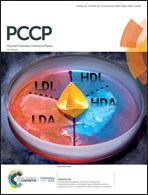New application of in silico methods in identifying mechanisms of action and key components of anti-cancer herbal formulation YIV-906 (PHY906)†
Abstract
YIV-906 (formally PHY906, KD018) is a four-herb formulation that is currently being developed to improve the therapeutic index and ameliorate the side effects of many chemotherapeutic drugs including sorafenib, irinotecan, and capecitabine. However, as a promising anti-cancer adjuvant, the molecular mechanism of action of YIV-906 remains unrevealed due to its multi-component and multi-target features. Since YIV-906 has been shown to induce apoptosis and autophagy in cancer cells through modulating the negative regulators of ERK1/2, namely DUSPs, it is of great interest to elucidate the key components that cause the therapeutic effect of YIV-906. In this work, we investigated the mechanism of YIV-906 inhibiting DUSPs, using a broad spectrum of molecular modelling techniques, including molecular docking, molecular dynamics (MD) simulations, and binding free energy calculations. In total, MD simulations and binding free energy calculations were performed for 99 DUSP–ligand complexes. We found that some herbal components or their metabolites could inhibit DUSPs. Based on the docking scores and binding free energies, the sulfation and glucuronidation metabolites of the S ingredient in YIV-906 play a leading role in inhibiting DUSPs, although several original herbal chemicals with carboxyl groups from the P and Z ingredients also make contributions to this inhibitory effect. It is not a surprise that the electrostatic interaction plays the dominant role in the ligand binding process, given the fact that several charged residues reside in the binding pockets of DUSPs. Our MD simulation results demonstrate that the sulfate moieties and carboxyl moieties of the advantageous ligands from YIV-906 can occupy the enzymes’ catalytic sites, mimicking the endogenous phosphate substrates of DUSPs. As such, the ligand binding can inhibit the association of DUSPs and ERK1/2, which in turn reduces the dephosphorylation of ERK1/2 and causes cell cycle arrest in the tumor. Our modelling study provides useful insights into the rational design of highly potent anti-cancer drugs targeting DUSPs. Finally, we have demonstrated that multi-scale molecular modelling techniques are able to elucidate molecular mechanisms involving complex molecular systems.



 Please wait while we load your content...
Please wait while we load your content...